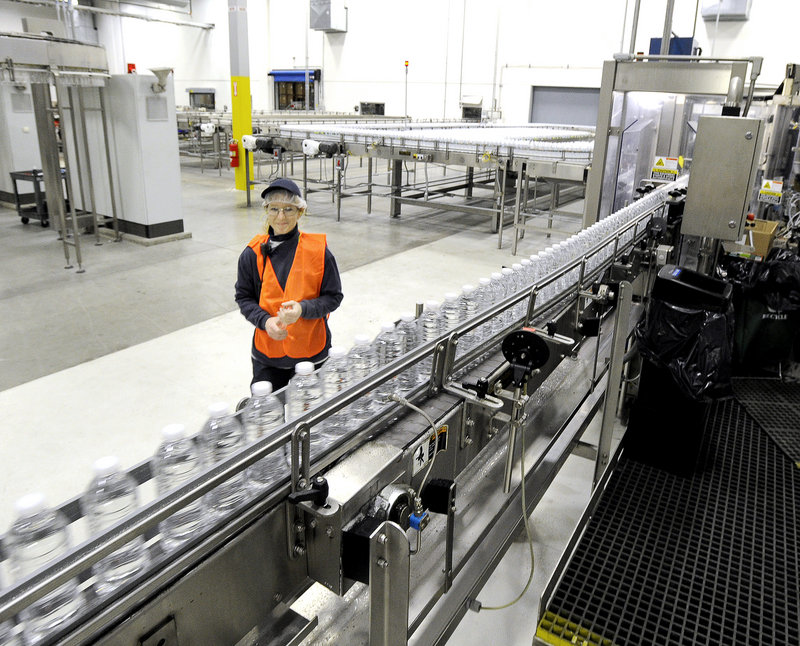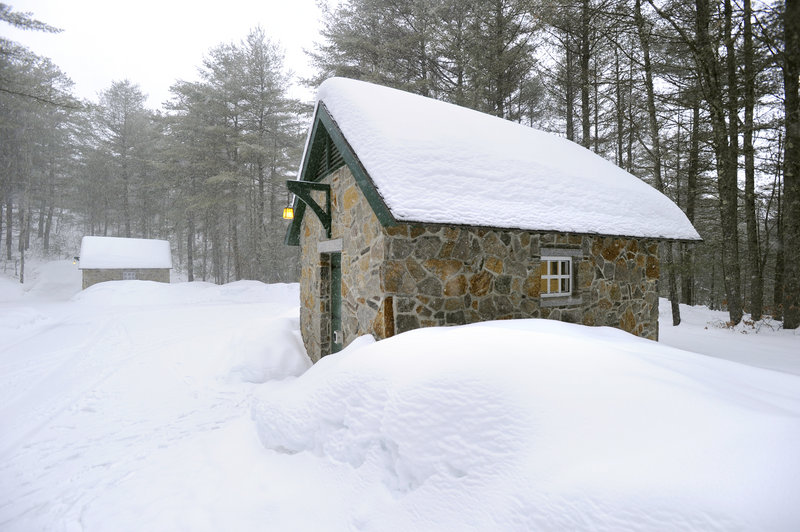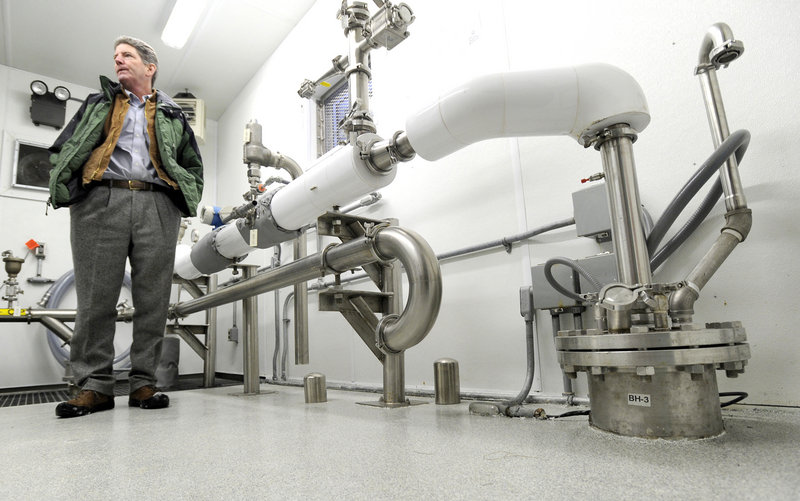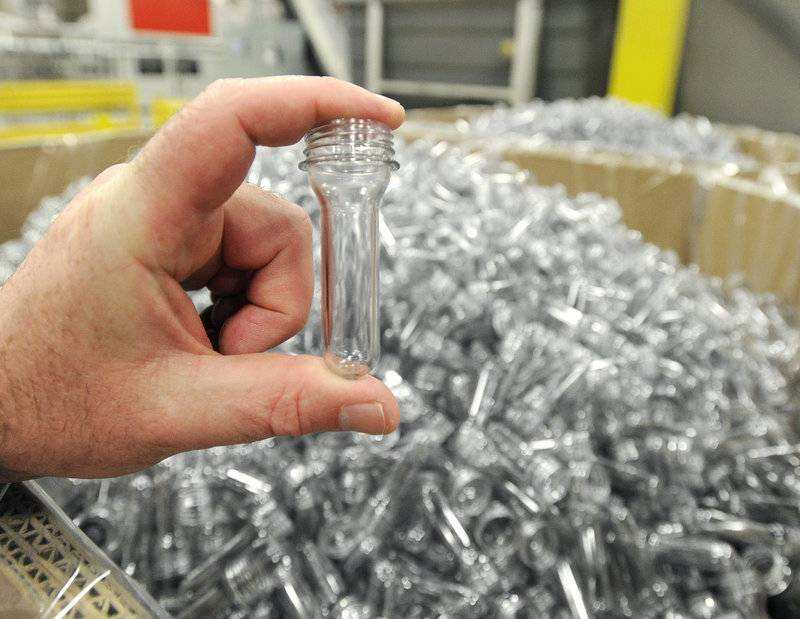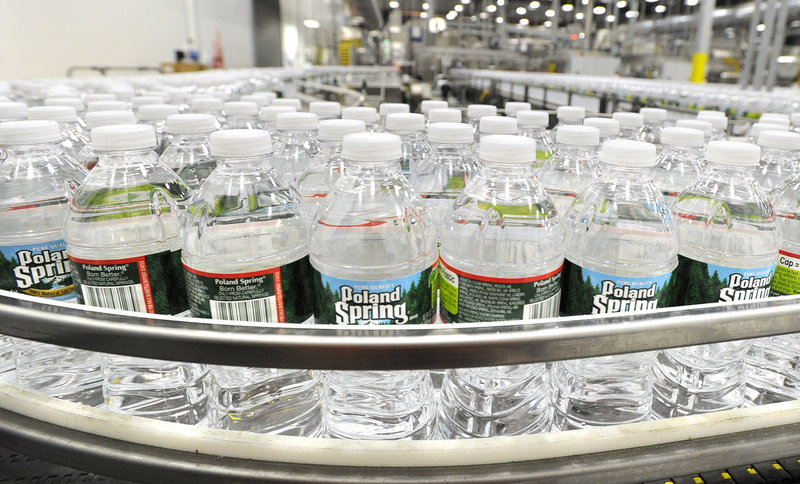HOLLIS – Business people in Maine frequently criticize the state’s regulations as overly complex and difficult to navigate.
But executives at Nestle’, which owns the Poland Spring brand, say the strict state and federal rules they follow ensure healthy water supplies.
Nestle’ has good reason to point to the regs — the company faces vocal opposition from environmentalists and other activists.
But by addressing public water use concerns, partnering with town officials and monitoring aquifer health, Nestle’ officials say the Poland Spring brand has grown responsibly, investing millions of dollars in Maine’s economy and hiring hundreds of skilled workers.
“We don’t mind regulations,” said natural resource manager Tom Brennan Tuesday at Poland Spring’s Hollis bottling plant. “We have to be absolutely focused on the stewardship of our resource. Our business would shut down instantly if those springs stopped springing.”
Poland Spring traces its history to the 1790s, when immigrants founded an inn at Poland Spring. The inn grew into a spa, and the owners began bottling spring water in 1845.
Perrier Group of America bought Poland Spring in 1980, when the company had only 25 staff and was near bankrupt, said William Maples, Nestle’s director of supply chain for the Northeast.
Perrier was later acquired by Nestle’ Waters North America, a Stamford, Conn., division of the Swiss company. About 800 people work at Poland Spring in Maine.
Officials would not discuss Poland Spring’s revenue, but Nestle’ Waters’ website said bottled water sales — including all of the division’s roughly 60 brands — totaled $4.2 billion in 2009.
And demand for bottled water is expected to grow in 2011, according to Gary Hemphill of Beverage Marketing Corporation. He estimates the segment was up 3.5 percent in 2010, after declining in 2008 and 2009.
Poland Spring bottles groundwater taken from nine sites throughout the state, including Fryeburg, St. Albans, Denmark, Pierce Pond, Dallas Plantation, Hollis, Kingfield and Poland.
Brennan said 13,000 years ago much of Maine was covered by a glacier, which, as it melted, deposited a layer of sand and gravel.
Those deposits function like a bathtub, holding rainwater and runoff. But the excess doesn’t trickle over the side, it bubbles from the ground at springs, he said.
Nestle’ gets water in Hollis through five bore holes, which are connected to the spring and housed inside a “bore hole building.” They look like rustic, one-room mountain cabins, but are tidy and locked electronically.
From the bore holes, water moves to an “intermediate pump station,” or IPS, where it is blended and sent about a mile to the Hollis bottling plant.
Between 345 and 425 employees work at the Hollis site, overseeing an array of computers and a lightning-quick production line.
Maples said the 838,000 square-foot facility is the largest bottled water plant in the world, turning out about 80 million cases of water every year. Some of the machines at Hollis can fill 1,200 bottles per minute.
“It’s huge. And we are here in the back woods,” he said during a tour last week.
The entire Poland Spring brand ships 135 million cases each year.
Hollis doesn’t just fill bottles, it also makes them, injecting hot resin into molds to create two- to five-inch long plastic test tube-shapes called “preforms.”
Another machine heats and blasts the preforms into actual bottles, which are filled, capped and labeled. The machines whirl at dizzying speeds and conveyors carry bottles too fast to count.
The Hollis plant runs all day and night, seven days a week and the company ships water throughout the Northeast.
Poland Spring water isn’t clean in the eyes of opponents, who they say the multinational corporation should not profit from community resources.
“Water should be recognized as a fundamental right for people in nature. Not a right conferred by people. It’s an inherent right,” said Ruth Caplan, a Washington, D.C.-based national coordinator for the Alliance for Democracy’s water program.
Caplan has protested outside Nestle’ Waters’ Connecticut headquarters.
She and others also fear Poland Spring will take too much water from Maine, damaging the aquifers. And they say Poland Spring contributes to the waste stream by shipping water — which flows virtually free to nearly every home — in plastic bottles.
In recent years, Caplan’s group and advocates like Denise Penttila, a Kennebunk resident and member of Save Our Water, and Jim Wilfong of H2O for ME, have tried to block Poland Spring’s expansions.
There was success in Wells, where the water district decided in 2009 not to sell water to Poland Spring following community opposition.
But the company has expanded in towns like Fryeburg and Kingfield.
Brennan, the natural resource manager, thinks much of the criticism is unfounded. He said the company conducts extensive research on Maine’s aquifers and the surrounding environment, and he personally meets with officials and concerned citizens in the towns Poland Spring operates.
And Brennan said a host of state and federal agencies regulate the company, including the Maine’s Department of Environmental Protection, Department of Conservation, the fisheries service, the Land Use Regulatory Commission, the Bureau of Parks and Land and the Maine Geological Survey.
Brennan said Poland Spring sends water data regularly to the DEP, which can “make us turn off the pumps.”
Also, he said Poland Spring uses a fraction of water withdrawn in Maine. A 2007 DEP report found that bottled water accounted for less than 1 percent of water used.
Maples, the supply chain head, said Poland Spring has reduced its use of plastic. Bottles once made with 14.5 grams of plastic now use 9.1 grams, he said.
Maples added that Poland Spring’s customers buy bottled water partly for convenience. If water was unavailable, they might buy soda or any number of competing drinks.
“If you are going to buy a convenience beverage, why not buy water?” he said.
Since 2000, Maples said, the company invested about $500 million in their operations in Maine and donated millions to charities and schools.
Hollis selectman Irving Ben Severance said the local plant has provided quality local jobs.
“The people I know there have excelled. The corporate mentality seems to be to take rising stars and help them in the future.”
Though Nestle’ has helped fund road improvements, Severance said truck traffic frustrates some residents.
And he said a half-dozen people are dedicated to forcing Poland Spring out of town.
“They resent the fact that it’s a foreign-owned company,” he said. “I point out that … it’s a global economy. Water is a precious resource. Why not market it, just as we did pine trees for paper mills?”
Others agree.
“We shouldn’t be villains in the state of Maine,” said Jim Milligan, part owner of Carrabassett Spring Water, which employs 10 people. “I think Poland is trying to be a good neighbor, and boy, we could use manufacturers in the state of Maine.”
There are other detractors.
N. Bryan Pullen, president of Summit Spring Water in Harrison, calls Poland Spring’s branding misleading.
“They use a bore hole, which is a well. How do you call well water spring water?” he said, adding that his bottled water bubbles to the surface naturally.
Law allows bore hole water be called spring water, but Pullen described differences.
“The final step, where water percolates to the surface, pulls away particulates. You end up with a purity that is exceptional,” he said.
Pullen said he can’t compete with Poland Spring.
“I could receive a premium price if I could delineate my water from theirs,” he said.
Brennan said in an e-mail that FDA rules require that bore hole water “match the chemistry of the water from the spring.”
Staff Writer Jonathan Hemmerdinger can be contacted at 791-6316 or: jhemmerdinger@mainetoday.com
Send questions/comments to the editors.

